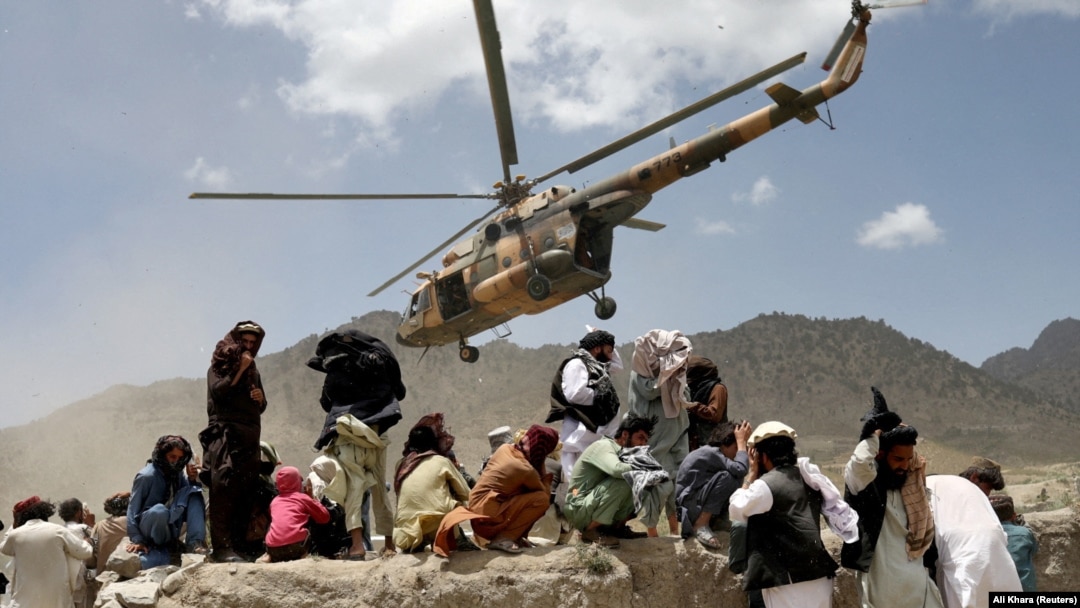Adil Khan and his family were sleeping in their mud-brick house when a magnitude-6.1 earthquake ripped through their remote village in Afghanistan’s southeastern province of Paktika.
By the time Khan crawled out of the destroyed house, many members of his extended family were buried under the rubble. Twenty-seven of them, including his wife and children, were dead.
They were among the over 1,000 people killed in a devastating earthquake that struck the region in the early hours of June 22. More than 1,500 people were also injured in the deadliest earthquake in Afghanistan in two decades. Officials have warned that the death toll could still rise.
"Entire families were wiped out,” Khan told RFE/RL’s Radio Azadi by phone. “All the survivors are busy burying their dead.”
Khan said he and other survivors in his village of Ochki, a settlement in the impoverished mountainous areas of Paktika’s Gayan district, were digging by hand through the rubble of their ruined homes in search of survivors.
WATCH: Efforts to reach communities in Afghanistan affected by the June 22 earthquake are being hampered by bad roads and heavy rain. The magnitude-6.1 quake is known to have killed at least 1,000 people and injured 1,500. The epicenter was 160 kilometers southeast of Kabul near the Pakistani border.
Your browser doesn’t support HTML5
Rescuers Battle To Reach Remote Epicenter Of Deadly Afghan Earthquake
Heavy rains and mudslides have hindered rescue efforts, forcing survivors to spend the night without shelter.
"Even our tools were buried in the rubble," said Khan, a university student, adding that the men in the village dug a line of graves to lay the dead to rest. "We had to hold mass burials."
Khan is not alone. The tremor destroyed over 3,000 houses and flattened entire villages in Paktika and the neighboring provinces of Khost and Nangarhar.
The areas affected by the earthquake are among the poorest and most remote in Afghanistan. Many live in poorly built mud-brick houses that cannot withstand natural disasters.
The earthquake has heaped more misery on a country where millions of people are already facing hunger and poverty following the Taliban's seizure of power in August 2021.
A man affected by the earthquake waits for relief in Gayan in Paktika Province on June 23.
The disaster is a major test for the hard-line Taliban-led government. Many Western donors have sanctioned the militants and stopped assistance to the country. The sudden halt in foreign aid and financing has fueled an economic meltdown and worsened the humanitarian crisis in the war-torn nation of around 38 million people.
The few foreign organizations still operating in Afghanistan, including the UN agencies, said they have sent supplies to the region, including medical kits and tents. But locals said that is unlikely to be enough given the scale of the destruction.
'We Lost Everything'
Esmatullah, another resident of Paktika’s Gayan district, near the epicenter of the earthquake, lost three brothers, sisters-in-law, and four nephews in the tragedy.
"We lost everything," he told Radio Azadi, adding that he was desperately searching for missing family members.
"The house where my brothers lived was wiped out," he said, adding that surviving family members had moved in with him. The average family in the region often has up to 20 members.
Survivors unable to bury their dead with their hands or shovels have laid them out in front of their houses and in their courtyards.
The Taliban said on June 23 that around 1,000 people had been rescued from the affected areas, which have been teeming with Taliban soldiers and ambulances as helicopters bring in relief supplies.
Kausar Uddin, another resident of Gayan, lost his father in the earthquake. He said the human toll on his family and community was staggering.
"In total, 26 of my relatives and neighbors were killed in our village," he told Radio Azadi. "Every village in our district has 25 or more dead.”


